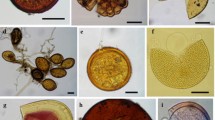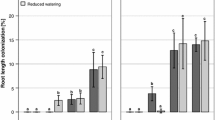Abstract
VESICULAR-ARBUSCULAR mycorrhizal fungi infect most higher plants and usually increase plant growth and phosphorus uptake, especially in infertile soils1. Mosse2–4 has shown that the indigenous mycorrhizal fungi in some soils are very infective but much less efficient in stimulating phosphorus uptake and plant growth than selected mycorrhizal fungi maintained in glasshouse pot culture. New Zealand soils have a short history of pastural agriculture (<150 yr) and still range in fertility from very phosphorus-deficient podocarp–broadleaf forest soils to well developed and highly fertile pasture soils. Most hill country pastures consist of introduced grasses and legumes which are invariably mycorrhizal5,6. These pastures have been developed within the past 100 yr from infertile forest soils in which nearly all plants were mycorrhizal7 and many were completely dependent on mycorrhizal infection for phosphate uptake and plant growth8,9. Many forests are still being cleared and brought into pasture by oversowing with white clover and spreading heavy dressings of superphosphate. It is important to know whether the indigenous mycorrhizal fungi adapted to these infertile forest soils are as effective at stimulating clover growth in highly fertilised pastures as an efficient mycorrhizal fungus such as E3 (ref. 10), a Glomus species from Mosse's Rothamsted collection.
Similar content being viewed by others
References
Mosse, B., A. Rev. Phytopath., 11, 171–196 (1973).
Mosse, B., Hayman, D. S., and Ide, G. J., Nature, 224, 1031–1032 (1969).
Mosse, B., and Hayman, D. S., New Phytol., 70, 29–34 (1971).
Mosse, B., in Endomycorrhizas (Academic London, 1975).
Crush, J. R., N.Z. J. Bot., 11, 645–660 (1973).
Crush, J. R., N.Z. J. agric. Res., 18, 361–364 (1975).
McNabb, R. F. R., thesis, Otago Univ., New Zealand (1958).
Baylis, G. T. S., New Phytol., 66, 231–243 (1967).
Baylis, G. T. S., in Endomycorrhizas (Academic, London, 1975).
Mosse, B., Powell, C. L., and Hayman, D. S., New Phytol., 76, 331–342 (1976).
Phillips, J. M., and Hayman, D. S., Trans, Br. mycol. Soc., 55, 158–161 (1970).
Mountier, N. S., Grigg, J. L., and Oomen, G. A. C., N.Z. J. agric. Res., 9, 328–338 (1966).
Author information
Authors and Affiliations
Rights and permissions
About this article
Cite this article
POWELL, C. Mycorrhizal fungi stimulate clover growth in New Zealand hill country soils. Nature 264, 436–438 (1976). https://doi.org/10.1038/264436a0
Received:
Accepted:
Issue Date:
DOI: https://doi.org/10.1038/264436a0
- Springer Nature Limited
This article is cited by
-
Fine root endophytes under scrutiny: a review of the literature on arbuscule-producing fungi recently suggested to belong to the Mucoromycotina
Mycorrhiza (2017)
-
A history of research on arbuscular mycorrhiza
Mycorrhiza (2004)
-
Revegetation of serpentine substrates: Response to phosphate application
Environmental Management (1987)
-
Growth responses of several plant species to mycorrhizae in a soil of moderate P-fertility
Plant and Soil (1983)
-
Researching the potential of forest tree mycorrhizae
Plant and Soil (1983)





